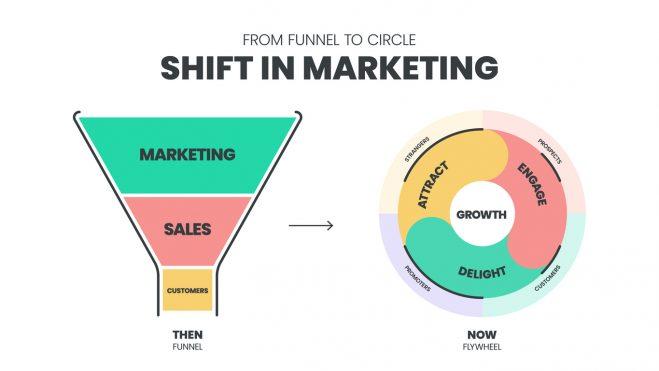As an experienced salesperson, you’ve likely noticed that the industry is constantly undergoing changes that influence the typical buyer’s journey. Figuring out how to generate more quality leads or increase closing rates requires tapping into how the average customer thinks and responds to sales strategies.
For the past several years, the traditional marketing funnel was the go-to model for enhancing customer acquisition tactics and identifying potential hangups. While the funnel is still fairly effective, it does come with a few limitations such as mostly being focused on the acquisition aspect of the buyer journey.

From funnel to circle Shift in Market infographic template with icons. Shift from the sustainable Marketing Funnel to the sustainable growth Marketing Cycle concepts. Presentation illustration vector
Now, the flywheel marketing strategy is taking the lead for being a more effective and sustainable approach to driving growth in the current customer-centric market. Taking a look at how the flywheel empowers sales teams with more qualified leads can help you plan for its use to create a smoother sales process for your company.
Being Realistic About the Limitations of the Funnel (Why the Flywheel Is Better)
The traditional marketing funnel involves taking a customer through a journey that includes these primary points:
•Awareness
•Interest
•Desire
•Action
As you might already be able to see, this is a one-way journey that ends quickly at the point of the customer taking action to purchase a product or service. The intense focus on customer acquisition rather than retention often means that sales quickly drop off once the bulk of the buyers have made their decision.
The funnel marketing approach also creates customers as an afterthought once the sale is complete. It’s also common to lose customers at each stage due to friction that occurs between marketing and sales. If a customer gets stuck anywhere along the way, it’s difficult to get them back.
Introducing the Flywheel Marketing Strategy
The flywheel model is a self-sustaining cycle of growth that uses customer satisfaction and engagement to fuel its momentum. Instead of focusing on a one-way model that ends with a purchase, the flywheel invites customers to move through these three stages in a continuous loop that emphasizes their experiences.
•Attract
•Engage
•Delight
All of the stages in the flywheel model are interconnected. Once a customer is attracted to your company’s goods or services, the flywheel calls for strategies that help to keep them engaged and delighted with their decision. Naturally, a positive customer experience will lead to more return business along with word-of-mouth referrals that spark your company’s growth.
Empowering Sales Teams With the Flywheel
Giving sales teams the tools they need to convert quality leads into satisfied customers is the key to meeting and exceeding targets. Exploring these benefits of the flywheel for empowering your sales team gives you insight into why using the model is what can take your company to the next level of growth.
Higher Quality Leads
The “Attract” stage of the flywheel model maximizes the earliest introduction that customers have to your company’s products and services. This stage utilizes valuable content along with targeted marketing to bring in highly qualified leads for your sales team to work with.
Shorter Sales Cycles
As customers enter the “Engage” stage, your sales team can focus on nurturing leads to build lasting relationships. Tapping into what customers need and making connections makes it easier to close deals faster.
Increased Closing Rates
Keeping customers engaged and delighted naturally results in repeat customers and advocates that help generate more leads that support sales efforts.
Improved Sales and Marketing Alignment
The interconnected parts of the flywheel model foster collaboration between sales and marketing teams. Establishing a unified approach to customer acquisition and retention helps everyone meet their goals.
More Predictable Revenue Growth
The continuous loop created by the flywheel helps to generate sustainable growth that also increases the accuracy of revenue forecasting.
Taking Actionable Steps to Implement the Flywheel Marketing Strategy
By now, the wheels may already be turning in your mind regarding how the flywheel marketing strategy can transform your sales team. You can use these ideas to begin adding the flywheel to your sales tactics.
Attract: This is where you want to begin bolstering content marketing efforts by using SEO and other effective strategies. Social media campaigns can help spread the word about your company, and you’ll want to focus on inbound marketing, too. As you do, remember that creating valuable content that resonates with the target audience is what generates the best leads.
Engage: Begin intensely focusing on building relationships and providing valuable information to the target audience. Personalization is key at this stage, and automated email marketing can heighten the impact of your brand’s messages. Chatbots, CRM integration, and lead nurturing are additional strategies to implement to get the flywheel moving.
Delight: Exceeding customer expectations and creating brand advocates sends the flywheel model through its full cycle. Your sales team can achieve this goal by providing top-notch customer support along with feedback mechanisms that support community building. Loyalty programs also help to maintain momentum from this stage to the next.
Measuring Flywheel Performance
Knowing which metrics matter the most for flywheel models helps your team track and measure the success of the strategies you implement. These key metrics are indicators to watch for as you begin using the flywheel model:
•Website traffic and engagement metrics
•Lead generation and conversion rates
•Customer satisfaction (CSAT) and net promoter score (NPS)
•Customer churn rate
•Customer lifetime value (CLTV)
Discovering How Semgeeks Supports Companies Implementing the Flywheel Model
While you might be hearing about the flywheel for the first time, our team at Semgeeks has been hard at work learning everything we can about how to help businesses implement and optimize this strategy.
Our expertise extends to using each stage of the flywheel to drive growth and sales for our clients. We’ve been using strategies that promote lead generation and customer retention for years, and we make it a point of pride to constantly update the techniques we use for content marketing and social media campaigns.
We offer automated email marketing and build feedback mechanisms into our plans. With our analytics, we can also help to identify roadblocks and successes in the flywheel approach to enhance the results of every campaign.
Take a Customized Approach to Implementing the Flywheel Model
The days of using the marketing funnel are over, but using flywheel marketing can easily take its place and raise sales performance levels higher. Achieving greater sales and marketing alignment begins with using the flywheel to transform the customer experience. When it’s time to revamp your current sales plans, our team has the experience and know-how to provide your company with a customized approach to flywheel implementation.
Are you ready to begin spinning your flywheel? Contact our team today for a free consultation that puts your next sales and marketing campaign into motion.
